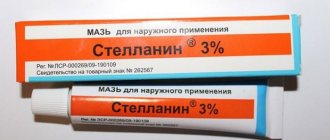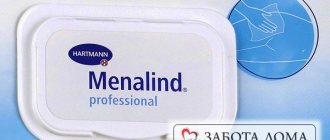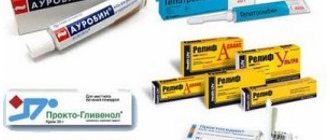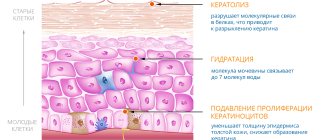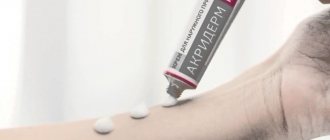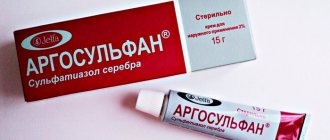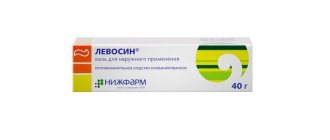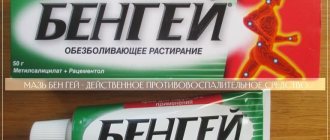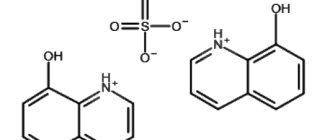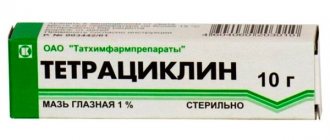Small wounds on the skin can become a source of inflammation and infectious damage to skin tissue and muscle fibers. Stellanin PEG ointment will help cope with such problems.
Stellanin PEG is a dosage form in the form of an ointment that has antimicrobial, antibacterial, wound healing, and anti-inflammatory effects on skin tissue. The ointment is used for the treatment of suppuration on the epidermis and soft tissues, the treatment of thermal burns, and trophic ulcers. The product eliminates bedsores; it is used to treat wounds, abrasions, postoperative sutures and other damage to the skin and muscle layer.
Release form and composition
Both forms of Stellanin release and the features of their composition are discussed below:
- Ointment 3% based on diethylbenzimidazolium triiodide is sold in 20 g tubes; active substance content – 0.6 g. Dimexide is present as an auxiliary component; the preparation also contains petroleum jelly, glycerin and povidone.
- Drops can be used for oral or external use; this form of “Stellanin” is sold in 25 ml bottles. 1 ml of the drug contains 40 mg of diethylbenzimidazolium triiodide.
Stellanin: ointment composition, packaging
Content
Both dosage forms are made on the basis of the active ingredient: diethylbenzimidazolium triiodide, which belongs to the pharmacological group of regenerants and reparants intended to provide bactericidal and regenerative effects. They are produced as a separate medicinal product and are intended for prescription, if appropriately prescribed by the attending physician. Stellanin ointment, in addition to the current active ingredient, contains petroleum jelly and glycerin, as well as povidone (low molecular weight polyvinylpyrrolidone) - a hematotropic agent with a detoxifying and adsorbing effect. The prepared composition has a brownish color and a characteristic specific odor.
Stellanin PEG includes, in addition to diethylbenzimidazolium triiodide and povidone, polyethylene oxide 400 and 1500 and dimexide, which has a fibrinolytic and antiseptic mechanism of action. The resulting composition is approximately the same color as the main preparation, but with a less pronounced and less characteristic odor.
Both drugs belong to the pharmacological group of drugs for stimulating regenerative processes. 100 g of ointment contains 3 g of active substance. An aluminum tube contains 20 g of ointment. Each is packaged in a cardboard box and supplied with instructions for use.
What is the difference between Stellanin and Stellanin PEG?
In pharmacies you can find a drug called “Stellanin PEG”, it is also a stimulator of regenerative processes in the epidermis.
The main differences between these tools are as follows:
| "Stellanin" is intended for the treatment of dry wounds, injuries and areas of inflammation. The composition is selected in such a way as to ensure softening of the skin, deep hydration of the epidermis and reliable protection against infection, while natural regenerative processes are launched. | "Stellanin PEG" is intended for the treatment of weeping wounds and foci of purulent inflammation. It has a powerful effect on pathogenic foci, eliminates microbial microflora, promotes tightening and healing of open wounds. |
Stellanin
Stellanine PEG
How does Stellanin PEG ointment interact with other medications?
Stellanin PEG is not particularly advisable to use in combination with other antiseptics. You should not use the ointment with medications that contain mercury; you should also not apply it to the body with oxidizing agents, alkalis, or cationic surfactants. Acidic, alkaline environments, suppuration, and excess fat weaken the antiseptic effect of the product.
The side effect of the composition comes down to all sorts of allergenic reactions of the patient’s body. Skin rashes, itching, and hyperemia of the skin are possible. In case of all these manifestations, you should urgently stop using the product.
How to get rid of inflammation on the skin?
IMPORTANT: Under no circumstances should the composition be applied to the mucous membranes of the body. If the product gets into the eyeball, you must immediately rinse the mucous membrane with lukewarm water.
The shelf life of the ointment is about two years. Store the consistency in a room with dry air at a temperature of 5 to 25 degrees.
pharmachologic effect
The main active ingredient that ensures the therapeutic effectiveness of Stellanin is diethylbenzimidazolium triiodide.
This component has the following pharmacological effects:
- Direct impact on local damage to the skin and soft tissues with subsequent stimulation of their recovery.
- Destruction and suppression of the activity of protein compounds and enzymes of bacteria, which leads to their death.
- Providing a protective layer on the surface of wounds to prevent secondary infections.
Pharmacokinetics and pharmacodynamics
- Stellanin ointment can be used to treat open wounds; in any case, the active substance of the drug is not absorbed into the blood.
- Its maximum concentration in the damaged area is observed 2–3 hours after treatment; The retention period in the body is on average 4–5 hours.
Stellanin PEG: composition, how does the drug work?
Every hundred grams of ointment contains three grams of the main active ingredient: 1,3-diethylbenzimidazolium triiodide. The product also contains components such as povidone, polyethylene oxide, and dimexide.
Stellanine PEG
The ointment exerts its effect thanks to 1,3-diethylbenzimidazolium triiodide:
- This substance is capable of activating the enzyme protein of microorganisms, and the component also acts on the walls of harmful bacteria, thereby destroying them in the affected skin cells.
- The ointment has the property of drying purulent wounds due to its ability to draw out liquid.
- The product accelerates the physiological regeneration of skin cells. After research, scientists found that Stellanin PEG increases the quantitative composition of fibroblasts by almost seven times.
Using Stellanin PEG ointment, you can prevent infection of the affected skin surfaces, thanks to this there will be no inflammation. Therefore, the wound will heal faster and the healing process of the affected area will accelerate. Deep cuts will not cause scar tissue to form.
Stellanin PEG does not have a systemic effect on the patient’s body; more precisely, the active substance is not able to penetrate into the blood. Even when the product is applied to open wounds. But the dosage form has a good therapeutic effect for a long time.
Indications for use
The use of Stellanin ointment is prescribed if the patient has one of the following indications:
- Ulcerative lesions of the legs caused by poor circulation.
- Damage or necrosis of soft tissues resulting from systematic pressure, friction or other mechanical influence.
- Thermal burns 1st and 2nd degree.
- Insect bites.
- Various damage to the integrity of the skin, including cuts, abrasions and cracks.
- Rehabilitation period after surgical interventions if antiseptic treatment of sutures and wounds is necessary.
- Rehabilitation period after skin grafting operations.
- Various forms of hemorrhoids.
Treatment approaches
Treatment of bedsores in conservative medicine is carried out in two ways or approaches:
- Traditional approach.
- Innovative approach.
| Name of approach | Description | Disadvantages/Advantages |
| Traditional | Step by step, various drugs are used, a specific treatment regimen is formed: first, antiseptics are used, which do not contain antibiotics, then antibacterial drugs with antibiotics are added. In treatment regimens for stages 2-3 of the pressure ulcer process, it is no longer possible to do without fermented and regenerating dosage forms. | A number of disadvantages can be identified with this therapeutic approach, these are:
|
| Innovative, based on Stellanin ointment | From the very first day of therapy, the fight against pressure ulcers occurs simultaneously in several directions:
| Advantages of this approach:
|
Contraindications
"Stellanin" is not allowed to be used if the patient has the following contraindications:
- Intolerance and the occurrence of an allergic reaction to substances included in the ointment.
- Increased activity of the thyroid gland, leading to the production of excess hormones.
- Benign neoplasms in the thyroid gland.
- Diseases leading to deterioration of kidney function.
- Undergoing therapy involving the use of radioactive iodine.
- Pregnancy in the 1st trimester.
- Age under 18 years.
Chronic kidney disease during remission is not a direct contraindication for the use of Stellanin, but the drug should be used with extreme caution and under the supervision of a physician.
Negative Impact
When applying the ointment to the skin (especially when capturing the healthy layer around the wound to avoid the spread of infection), itching and redness may be observed, caused by individual immunity to one of the components of the drug, or the occurrence of an allergic reaction. In case of contact with the mucous membrane, burning and redness may occur; such options should be avoided, especially in relation to the mucous membrane of the eyes. No other side effects were noted, since the drug is not absorbed systemically.
Directions for use and dosage
Features of the use and dosage regimen of "Stellannia" in the form of an ointment are given below:
- The ointment is intended only for external application to damaged areas; oral administration is prohibited.
- The ointment is carefully applied to the damaged area of the skin : it is necessary to avoid excessive pressure, but at the same time make sure that the product completely covers the damage with a thin layer.
- The maximum daily dosage, regardless of indications, should not exceed 10 g.
- When treating open wounds, a tape or waterproof dressing may be applied to protect them after treatment.
- When treating ulcers with minor fluid discharge and burns, the thickness of the ointment layer should be 1-1.5 mm; After the procedure, it is necessary to apply a sterile gauze bandage, which is recommended to be replaced once a day.
- When treating ulcers and burns, treatment is carried out once a day; when treating wounds that violate the integrity of the skin, treatment is carried out 2 times a day.
- The duration of the course is determined individually; it depends on the positive dynamics and rate of epithelium formation in the damaged area.
Before using Stellanin ointment, you must read the instructions supplied with the drug and make sure there are no contraindications.
Overdose
An overdose when using Stellanina ointment is impossible due to the lack of systematic absorption of the active substance.
However, if the permissible doses are significantly exceeded, the therapeutic effectiveness of the drug decreases and the risk of an allergic reaction increases.
Signs of departure, accompanied by nausea and vomiting, may occur if the ointment accidentally enters the digestive system.
In this case, you will need to perform gastric lavage, take activated charcoal and seek professional help from specialists.
The effectiveness of the drug Stellanin ointment
The effectiveness of the drug depends on its targeted action and auxiliary components. Stellanin ointment, intended for the treatment of dry wounds, does not have a systemic effect and remains on the wound surface to provide a pronounced therapeutic effect. In order to optimize absorption and soften wound hardening, it contains glycerin and petroleum jelly. Triiodide has an inactivating and destructuring effect on the enzymes and proteins of purulent bacteria contained in the wound, and povidone has an adsorbing and detoxifying effect. In this way, the development of wound infection is inhibited and waste products of pathogenic bacteria, which have the ability to corrode tissue and poison the cells surrounding the wound, are removed.
Stellanin PEG, which contains dimexide, simultaneously disinfects the wound surface, providing an antiseptic effect, and gives a mild osmotic effect. It promotes the removal and elimination of purulent contents, causes a fibrinolytic (blood-clotting, reparation and anti-inflammatory effect. This mechanism of action determines its indications for the treatment of a constantly weeping surface. The active active substance is used both as a separate drug and as part of drops, but Stellanin ointment - a unique medicinal composition, the effectiveness of which is achieved through a combination with two or more auxiliary components, which increase the therapeutic potential of the product developed by the RNFO Stellanin is an ointment with a unique effect: existing industrial analogues have similar capabilities to a much lesser extent.
Drug interactions
Stellannin ointment, as prescribed by a doctor, can be included in complex therapy, but with the simultaneous use of various drugs for application to the skin, it is necessary to separate the procedures in time.
Due to undesirable drug interactions, the simultaneous use of ointment and the following drugs is prohibited:
- Antiseptics in any form containing mercury.
- Pharmacological drugs that shift the environment to the alkaline side.
- Preparations for topical use with an oxidizing effect.
- CPAV.
In the presence of open bleeding in the treated area, a decrease in the bactericidal parameters of the ointment is observed.
For acne
Stellanin ointment is an effective remedy in the fight against acne, not only judging by the reviews of patients, it has also proven its effectiveness in clinical trials.
This medicine copes well with the inflammatory process. If there is a small amount of acne, you need to apply a little product to the acne, cover it with a napkin and fix it with a medical plaster. In case of a large number of acne, the ointment should be applied to the face (leaving the area around the eyes untouched) in a thin layer.
Treatment should be done in the evening before bedtime. In the morning, any remaining medication should be washed off with water. The duration of therapy must be continued until the acne disappears completely.
Price
Stellanin can be purchased at most pharmacies, but to purchase the ointment you will need to first obtain a prescription from your doctor. The cost of a tube containing 20 grams of ointment averages 400–500 rubles .
Storage conditions and expiration dates
“Stellanin” in the form of an ointment can be stored for 2 years from the date of manufacture, provided that the integrity of the tube is maintained and the following rules are observed:
- Protection from sunlight.
- The temperature is not lower than 0 °C and not higher than + 25 °C (for drops the temperature range is +15 -25 °C).
- Normal air humidity levels.
You should make sure that pets and children do not have access to the ointment storage area. The drug must be kept separate from utensils and food to prevent accidental entry into the digestive system.
Analogs
If it is impossible to use Stellanin in the form of an ointment, the attending physician may prescribe one of the analogues that has a similar effect:
- “Iodine” is a budget analogue of “Stellanin” ointment; the drug is available in the form of a solution for topical use and has the same indications and contraindications for use. The main active ingredient is polyvinylpyrrolidone iodine, the cost in pharmacies starts from 350 rubles .
- "Betadine" is a 10% ointment based on povidone-iodine; has antiseptic properties and is used to treat many dermatological diseases. The average cost of a 20 gram tube is 300 rubles .
- "Iodopirone" is available in the form of a 1% solution for topical use; The effectiveness of the antiseptic is due to the combined effect of potassium iodide and povidone-iodine. The average price of a 50 ml bottle is 220–250 rubles .
- "Panthenol" in the form of a 5% ointment based on dexpanthenol is prescribed if the patient has contraindications to the use of pharmacological drugs based on iodine. The cost in pharmacies starts from 120 rubles .
- "Levomekol" is another skin tissue regenerator that has an antibacterial effect. The active ingredients are chloramphenicol and methyluracil; Unlike Stellanin, the ointment does not contain iodine, so the only contraindication is individual intolerance to the product. The cost in pharmacies starts from 120 rubles .
- "Vinilin" also known as Shostakovsky balm, is a liquid for topical use based on polyvinox. The drug has a pronounced antimicrobial and antiseptic effect; it is used to treat purulent lesions, inflammation, trophic ulcers, skin rashes and damage to the integrity of the skin and tissues. The cost, depending on the volume of the bottle, varies from 120 to 250 rubles .
Iodine Betadine
Iodopyrone
Panthenol
Levomekol Vinilin
Despite the relative safety of Stellanin for external use, prior approval of treatment involving the drug with a specialist will be required, since the ointment cannot be purchased without a prescription.
Stellanin ointment: price, reviews
Despite such a wide spectrum of action of the drug, its price is not so high, approximately 370 rubles. Much in determining the cost of a product depends on the brand of the manufacturer. Stellanin PEG is very popular among patients. User reviews are mostly positive, more details below.
How to get rid of scars?
Alla, 29 years old:
In my situation, the product did not fulfill its purpose. I bought Stellanin PEG on the advice of a pharmacist for the treatment of boils. Unfortunately, the composition did not help me at all. As a result, I went to the doctor, he advised me another drug that completely solved my problem.
Lyubov, 43 years old:
I treated a burn with this ointment. I always keep it in my medicine cabinet. When you get injured, you must immediately treat it with ointment. Then there will be no redness or blisters. Another advantage of the drug is its price. Stellanine PEG is inexpensive compared to other burn and wound treatments.
Vasily, 38 years old:
Previously, I used other more expensive drugs to treat acne. A colleague recommended this ointment to me. Its price is an order of magnitude lower than other products with the same effect. There is one more drawback - it is difficult to find in pharmacies in our city. But when I have the opportunity to buy, I buy two tubes at once to stock up for the future.
Reviews
Like other iodine-based drugs, Stellanin has contraindications, the absence of which will need to be verified. Before using the product for the first time, it is recommended to conduct a trial test to ensure there is no allergic reaction.
Marina Maksimova
Gastroenterologist, Candidate of Medical Sciences and editor of articles at gastro911.com. For more than 10 years I have been helping to recover from gastrointestinal diseases.
